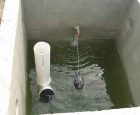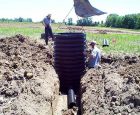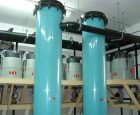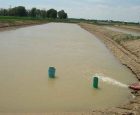
Features
Drainage Management Systems
Closed-loop management
System combines tile drainage, reservoirs and controlled drainage with irrigation for effective water management.
October 30, 2015 By Tony Palermo
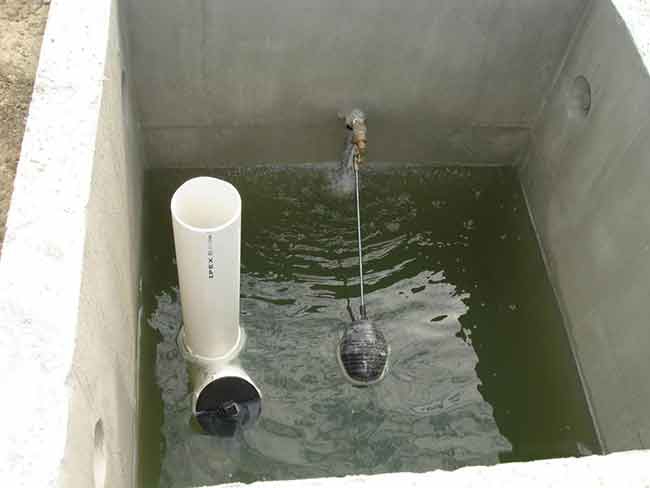 This controlled drainage sub-irrigation water management system performs best under relatively flat agricultural drained lands. The system was developed at AAFC’s Greenhouse and Processing Crops Research Centre in Harrow
This controlled drainage sub-irrigation water management system performs best under relatively flat agricultural drained lands. The system was developed at AAFC’s Greenhouse and Processing Crops Research Centre in HarrowResearchers at Agriculture and Agri-Food Canada (AAFC) have developed an innovative closed-loop water management recycling system that can offer farmers many benefits, including improved crop yields – but it may very well be another business opportunity for drainage contractors as well.
The system was developed at AAFC’s Greenhouse and Processing Crops Research Centre in Harrow, ON, and combines tile drainage, reservoir and controlled drainage with irrigation. It works by using strategically placed riser pipes, which can be installed on existing tile drainage systems, to prevent water from leaving the tile until it reaches a pre-determined level controlled by the farmer. The system is attached to a reservoir or artificial wetland to store excess water, which can then be returned to the field by using subsurface irrigation and/or drip irrigation during dry periods.
As Chin Tan, a water management and quality specialist with AAFC and the lead researcher for the system says, this new closed-loop water management system may very well be “a secret weapon for crop farmers.”
The team has also designed and developed a water quantity and quality data acquisition system for automated and remote monitoring of all surface and sub-surface tile drainage water in the fields.
“As water moves through the automated system, runoff volume, crop nutrient content and leached agrochemicals are continuously measured so that farmers can see — and, more importantly, explain — the differences between water management practices and resulting yields,” Tan explains, adding that year round, 24 hours a day, seven days a week, every drop is captured and measured.
And, that’s where the new water management system really starts to show its economic and environmental benefits.
Many benefits for the grower
Tan says part of the beauty of this closed-loop water recycling technology is that it collects water from multiple sources and not just from rainfall, which has a higher rate of evaporation from reservoirs. Surface run-off and tile drainage water is added to precipitation already collected during the “off” growing and winter seasons which prevents the wetland-reservoirs from drying up.
Because the wetland-reservoir acts as a sink of sorts, the system also prevents leached agrochemicals, nutrients and even sediments from reaching neighbouring land, in turn preserving wildlife habitats.
This also means that any nutrients captured are kept in the system.
“This is not only good for crops, it is good for the environment,” Tan says. “Nutrients captured in the reservoir are returned to the crops which reduces the farmer’s need for extra fertilizers. We estimate that this will contribute to a 25 to 50 percent reduction in nitrate loss.”
Improved water management results in better crop yields by reducing crop stress brought on by overwatering or drought conditions – so much so that research shows continuous closed-loop water recycling and management improves soybean yields by 50 percent, tomato yields by 40 percent and corn yields up to a whopping 95 percent. As Tan says, these results more than compensate for the land taken out of production for the reservoir.
“By learning how to save water for when it’s really needed, farmers will be able to take some of the guess work out of agriculture,” Tan says, “If farmers have water, they can have crop yield stability.”
Tan points to Dave Epp, a Leamington, ON, based tomato farmer with whom Tan has been working closely for approximately 20 years. He says by incorporating a reservoir closed-loop system, Epp has been able to increase yields to 50 tons per acre, which is significantly higher than the area’s average production level.
System has been well received
Tan says the system has been well received when presented at various international conferences, including at the International Conference on Environmental Indicators in Windsor, ON, this past August.
For high-valued cash crops, Tan believes this water management system can achieve both economic and environmental benefits within short periods without government incentive; however, with field crop production, he cautions it would take relatively long periods to achieve economic benefit.
“To ensure large-scale implementation of this new water management system, the initial government incentive and/or regulatory instruments can definitely help agricultural producers to adopt the new system to achieve both economic and environmental benefits,” Tan explains.
He also says this water management system performs best under relatively flat agricultural drained lands. In high slope areas, more modified control structures are needed to ensure the effectiveness of the water management system, resulting in a greater cost to producers looking to implement the system.
Because drainage contractors are familiar with different soil types and farming and draining practices, Tan says they are well equipped to offer advice to farmers looking to install such a system and improve their operation’s profitability and environmental performance.
Tile Placement
Tan says the soils in southwestern Ontario are mainly heavy textured clays. Using the Ontario Handbook of Drainage Principles to optimize water removal and determine tile depth, Tan says tiles are generally placed between 0.6 to 0.7 meters (two to 2.3 feet) in Ontario, compared to 1.2 to 1.5 meters (3.9 to 4.9 feet) in areas around the U.S. border in the Great Lakes Regions. As a result, drainage control levels in southwestern Ontario can be raised by only a modest amount, generally up to 0.15 meters (0.49 feet). Tiles around the U.S. border in the Great Lakes Regions can raise their drainage control level by up to 0.45 meters (1.5 feet).
Tan says the results of on-farm scale trials in Ontario indicate that drainage control can reduce nitrogen and phosphorus losses between 25 and 45 percent during the non-growing season; in the U.S. border area around the Great Lakes Regions, drainage control can reduce phosphorus losses anywhere from 40 to 65 percent during the winter months.
As long as the agriculture lands rely on the practices of drainage, Tan says the closed-loop water management system can be applied on a large-scale across Canada and the United States.
Print this page
